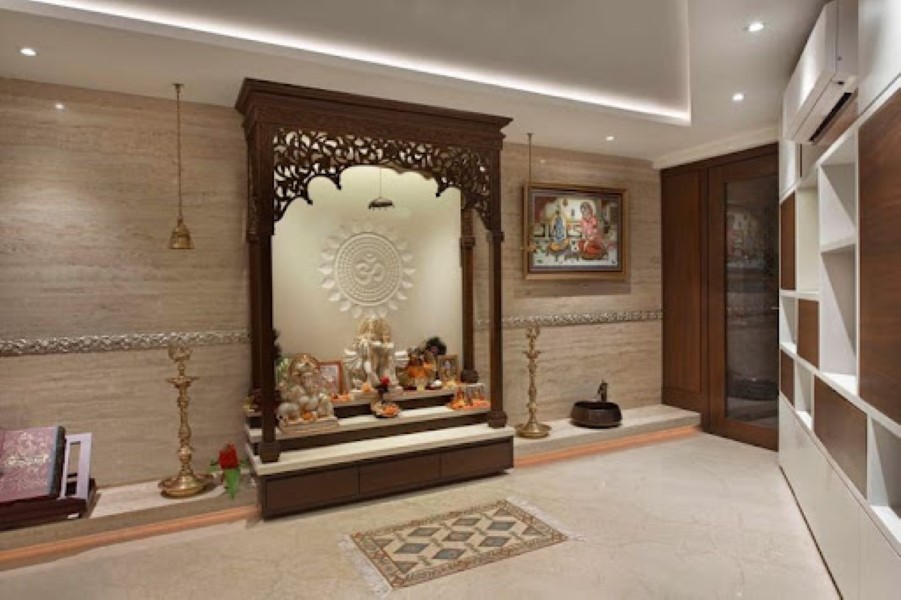
Incorporating Vastu Shastra in Living Room Mandir Design
In Indian culture, a mandir holds a sacred place within a home. It is a spiritual haven, where one can connect with a higher power and seek inner peace. The living room, being the heart of a house, often becomes the ideal location for a mandir. To ensure that positive energies flow freely within this space, it is essential to incorporate Vastu Shastra principles into the mandir design. This article will explore various ways to create a harmonious and serene living room mandir design for home that adheres to Vastu Shastra guidelines.
Table of Content
Choosing the Right Location:
According to Vastu Shastra, the northeast corner is considered the most auspicious position for a mandir. However, if placing the mandir in the northeast is not feasible, the east or north direction is also suitable. Avoid placing the mandir in the south, southwest, or below a staircase, as it can disrupt the flow of positive energies.
Mandir Placement and Direction:
The mandir should ideally face east or west. East-facing Trending Pooja Room bring positive energy and spiritual growth, while west-facing ones promote stability and prosperity. Ensure that the mandir is not directly facing the main entrance of the living room, as this may result in distraction and discomfort.
Design and Materials:
Choose a mandir design for home that complements the overall aesthetics of your living room. Opt for natural materials like wood or marble, which resonate well with positive energies. Avoid using glass or plastic, as they may create a sense of restlessness.
Illumination and Lighting:
Lighting plays a crucial role in creating a serene ambience in the mandir. Install soft, warm lighting to enhance the spiritual atmosphere. Consider using wall sconces or decorative lamps to highlight the mandir area. Ensure the lighting is subtle and doesn’t cause glare or shadows.
Mandir Color Scheme:
Colors have a significant impact on our emotions and energy levels. For a mandir design in living room choose calming colors like white, cream, light yellow, or light blue. These colors promote tranquility and peace. Avoid using dark or vibrant colors that may evoke strong emotions and disturb the serene atmosphere.
Organizing the Mandir Space:
Keep the mandir area clutter-free and well-organized. Arrange the idols or deities in a way that they face the center of the room. Ensure that the mandir space is always clean and free from dust or cobwebs. Regularly dust and clean the idols, lamps, and sacred items to maintain their positive energy.
Sound and Aromatherapy:
Incorporate elements of sound and aromatherapy to enhance the divine experience. Place wind chimes or bells near the mandir to create soothing sounds that purify the space. Additionally, use fragrant flowers, incense sticks, or essential oils to fill the air with a pleasing aroma, promoting a sense of calmness and spirituality.
Sacred Geometry and Symbols:
Consider incorporating sacred geometrical patterns and symbols in the mandir design. Using mandala patterns, yantras, or auspicious symbols like the Om symbol can create a visually appealing and spiritually uplifting environment.
Also Read:- Top 5 Important Vastu Tips for Your Living Room
Conclusion:
By incorporating Vastu Shastra principles in your living room mandir design, you can create a sacred space that radiates positive energy, promotes harmony, and nurtures spiritual well-being. Remember to choose an auspicious location, select the right materials, maintain a clutter-free environment, and create a serene ambience through lighting, colors, and sound. Embracing these guidelines will help you create a mandir design for home that provides tranquility and spiritual rejuvenation for you and your family.
Remember, the design of a mandir should resonate with your personal beliefs and preferences. Therefore, while adhering to Vastu Shastra principles, feel free to add your unique touch to create a space that brings you joy, peace, and spiritual solace.
Whether it’s a traditional wooden mandir or a contemporary marble design, let your living room mandir be a testament to your faith and a sanctuary for your soul.
For more inspiration and guidance on designing your living room mandir, visit reNNovate to explore a range of Trending Pooja Room that seamlessly blend spirituality and aesthetics.
Which Mandir Is Best For Home?
According to Vastu shastra, ideal Mandirs or temples are made of wood. A mandir made of wood is considered to be more religious and auspicious.
Which wood is best for a wooden mandir design for home?
Sheesham wood or rosewood is considered to be auspicious for your home temple or home mandir. However, you don’t need to use Sheesham wood for your pooja room or Mandir specifically. The other types of woods commonly used for making home mandirs are Sheesham wood, teak wood and Mango wood. You can pick any one of these wood types.
Which direction is best for the pooja room?
The ideal location of your pooja room or Mandir should be north-east as this location holds tremendous significance in Vastu shastra. Apart from the north-east direction, experts suggest that east and north directions are also ideal directions for your mandir design for home. The direction brings good luck and fortune to your home.
Which floor is best for the pooja room?
As per Vastu shastra, the ground floor of your home is ideal for your Mandir or pooja house. Also, the pooja room should never be in the basement or on elevated floors. Avoiding these placements can bring in maximum positivity and good omen.
How can I beautify my pooja room?
Here are a few tips to beautify your pooja home:
- Paint the puja room walls for a subtle yet vibrant statement
- Make use of effective and decorative lighting that helps to accentuate your Mandir
- Pick a unique pooja door design
- Decorate the floor
- Craft a beautiful backdrop
- Play with soft furnishings


